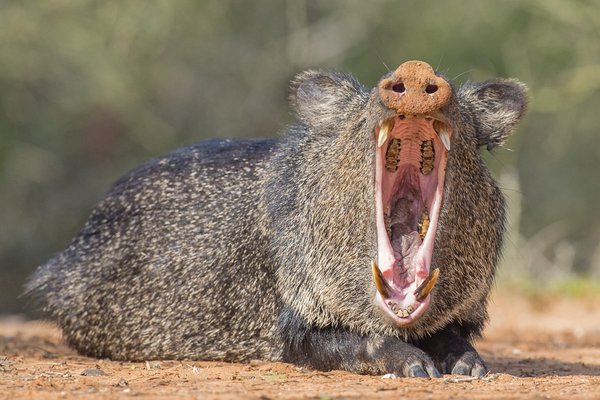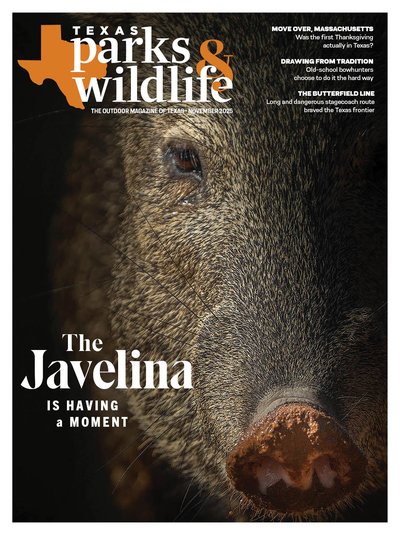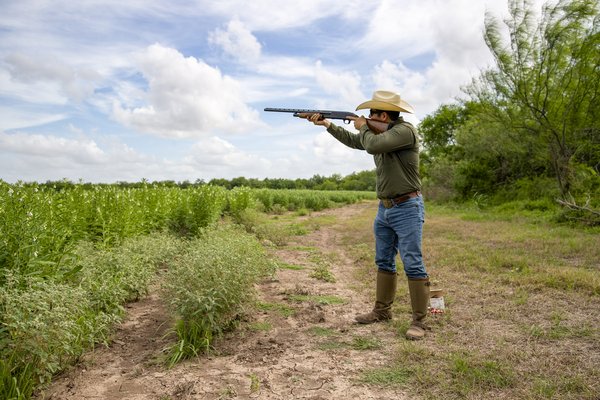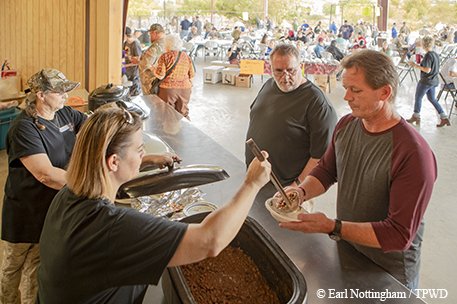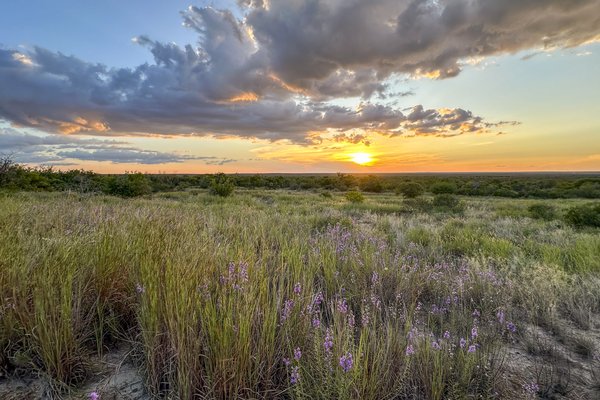On a still South Texas night, a group of javelinas roots around in the soft earth of Chaparral Wildlife Management Area. They’ve been coming to this location for a couple of weeks now — it’s proved to be a fruitful spot to have a snack of deer corn.
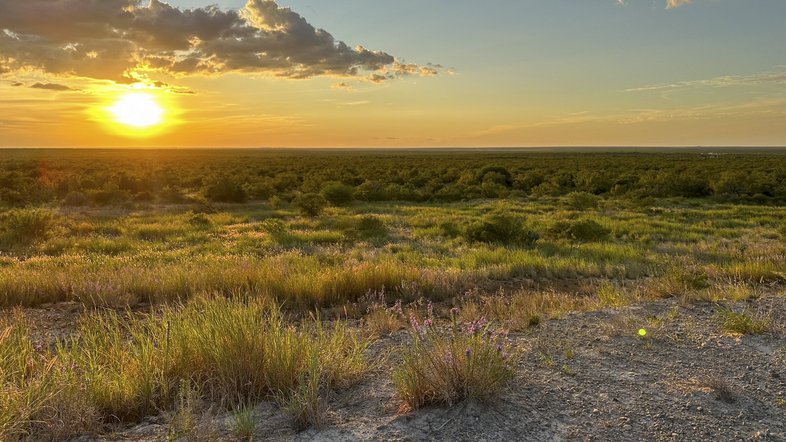
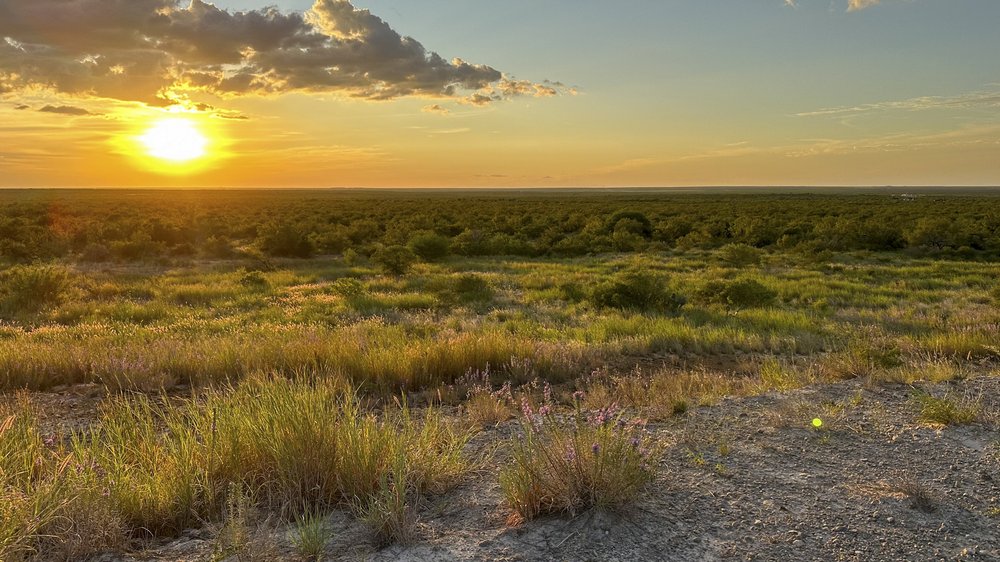
Javelina territory at Chaparral Wildlife Management Area.
Maegan Lanham | TPWD
Javelina territory at Chaparral Wildlife Management Area.
Maegan Lanham | TPWD
But tonight is not like those other nights. A short distance away, in the WMA’s bunkhouse, Texas A&M graduate students and their supervisor, Stephen Webb, are watching the javelinas on a game camera.
One by one, the animals make their way into a corral to get their fill of corn. “There’s two in there — can I drop it?” says one student, referring to a small gate that would trap the javelinas in the corral.
“I would get three,” says Webb. Soon enough, here comes another javelina, and then another, and then “Bang!” — the student presses the button to drop the gate.
“Now that we’ve hit the button and the animals are trapped, it really becomes go-time,” says Webb. He and the students pile into a pickup and head out.
After sedating the javelinas, the researchers begin collecting data. The gently snoring animals are measured, weighed and fitted with GPS collars so the team can track their movements. Within just a few minutes, the researchers are done, and the groggy javelinas begin to wake up and trot off into the brush.
Javelinas are an iconic native species, though the bristly little Texans don’t always get the respect they deserve. For one thing, javelinas are often confused with invasive feral hogs (they actually belong to a totally separate family and are more closely related to hippos than domestic pigs). For another, despite how well-known javelinas are in Texas popular culture, we know surprisingly little about how the species is doing in the state. Is the population growing or shrinking? How far do they roam, and where do they make their homes? These are some of the questions Webb and the research team are trying to answer.
In recent years, javelinas have most certainly been having a moment. Increased interest from hunters and scientists alike has elevated this game species to a research priority for the Texas Parks and Wildlife Department. “They’re worth studying,” says Whitney Gann, TPWD wildlife management area facilities coordinator and coordinator for the South Texas javelina project. “They’re worth the attention, and they’re worth the effort that we’re going to put into finding out this information. Javelina are such an iconic species in Texas, and it feels good to be a part of something so special.”
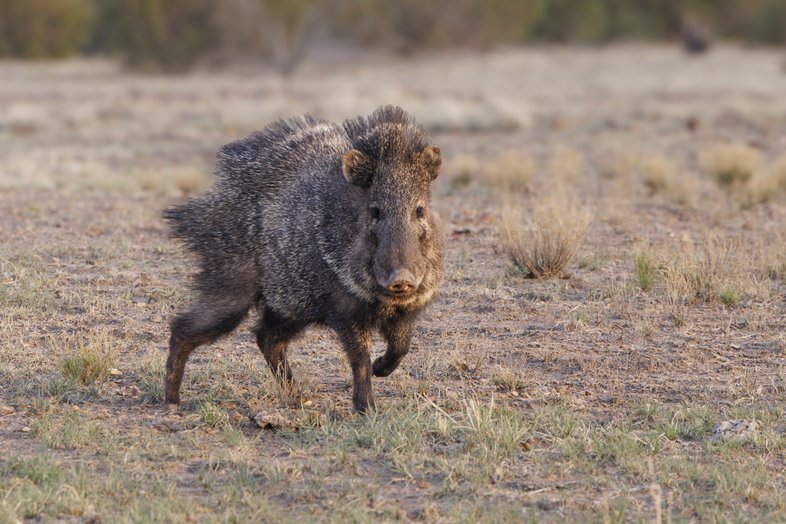

Javelinas are covered in dense, bristly hair.
Sonja Sommerfeld | TPWD
Javelinas are covered in dense, bristly hair.
Sonja Sommerfeld | TPWD
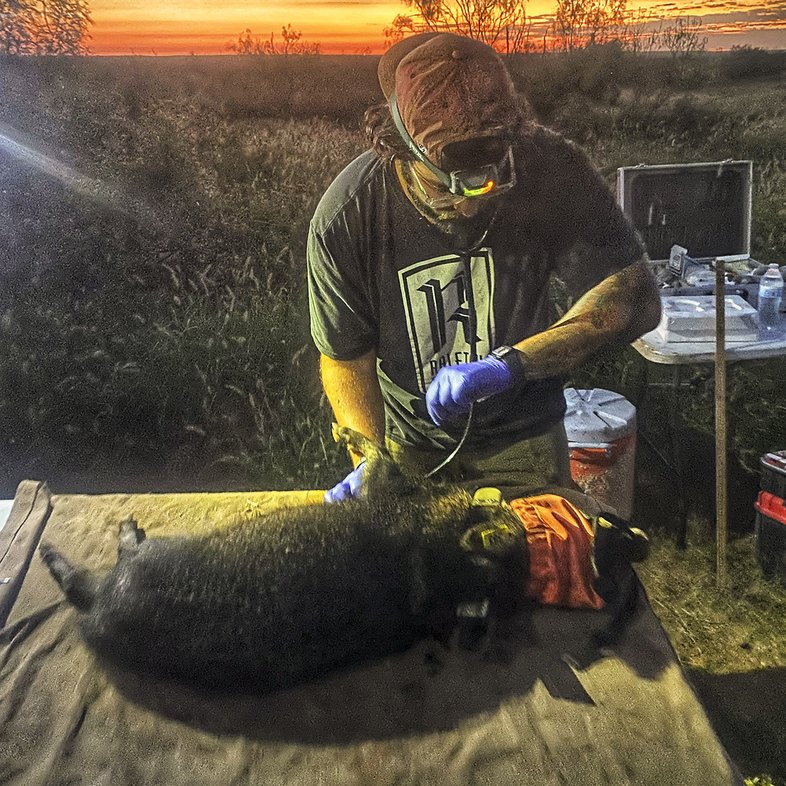
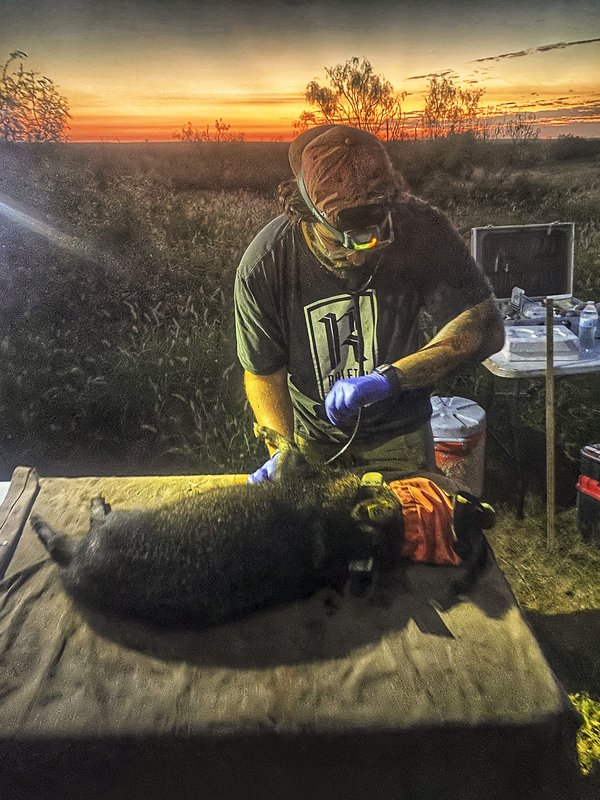
Javelina research will reveal more about the animals' range, biology and behavior.
TPWD
Javelina research will reveal more about the animals' range, biology and behavior.
TPWD
Hunting Javelinas
Javelina have been a game species in Texas for decades, and are a popular choice for a first hunt. When Texas A&M graduate student Edward Tomassetti, one of six graduate students conducting the javelina study, moved to Texas, he had never hunted. But as he progressed through his research, he felt that it was an experience he needed to have.
“I started having conversations about hunting and realized this was the perfect opportunity to learn and grow, so I jumped at it,” Tomassetti says. “Hunting became a natural extension of the values I’d developed: respect for wildlife, ethical sourcing of food and a desire to connect more deeply with nature.”
Tomassetti got invited on his first-ever hunt for javelinas on the Paloma Ranch in Maverick County, guided by Scott Krueger of Paloma Ranch and TPWD biologist Diego Navarro.
As a herd (also known as a squadron) of javelinas crossed an opening, Tomassetti raised his rifle for what he hoped was a clear shot, and squeezed the trigger.
Tomassetti’s rifle crackled. The javelina dropped instantly.
“My body and mind just blocked everything else out, and my concentration was hyper-focused,” he recalls. “I felt immense gratitude: for the animal’s life, for the people who made the hunt possible, for my position in Texas and for the deeper connection I felt to the land. It was a moment I’ll never forget.”
This wasn’t just any first hunt. Tomassetti was pursuing the very animals that filled his research notebooks and consumed his academic life.
“Most people have a story about their first hunt, but I think what makes mine unique is that I didn’t just harvest an animal — I harvested the very species that is shaping my future. It was a moment of true respect, reflection and reciprocity,” Tomassetti says. “This experience has deepened my relationship with my work and reaffirmed the importance of studying wildlife in a way that balances science, conservation and personal ethics.”
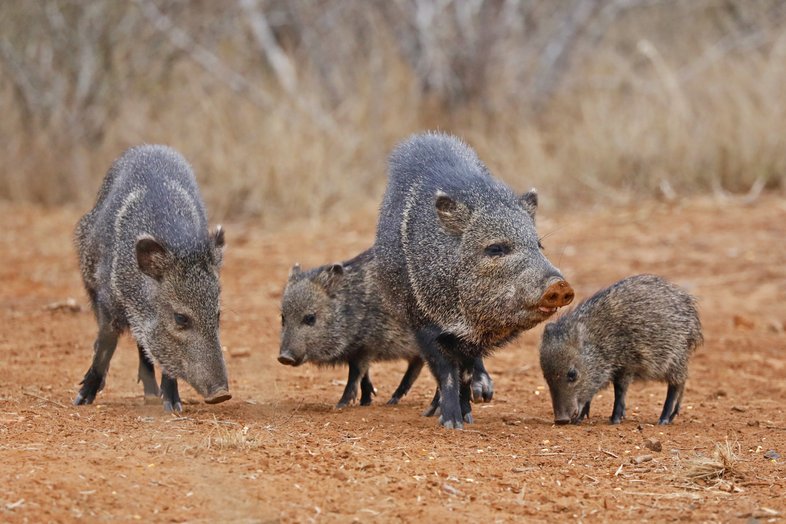
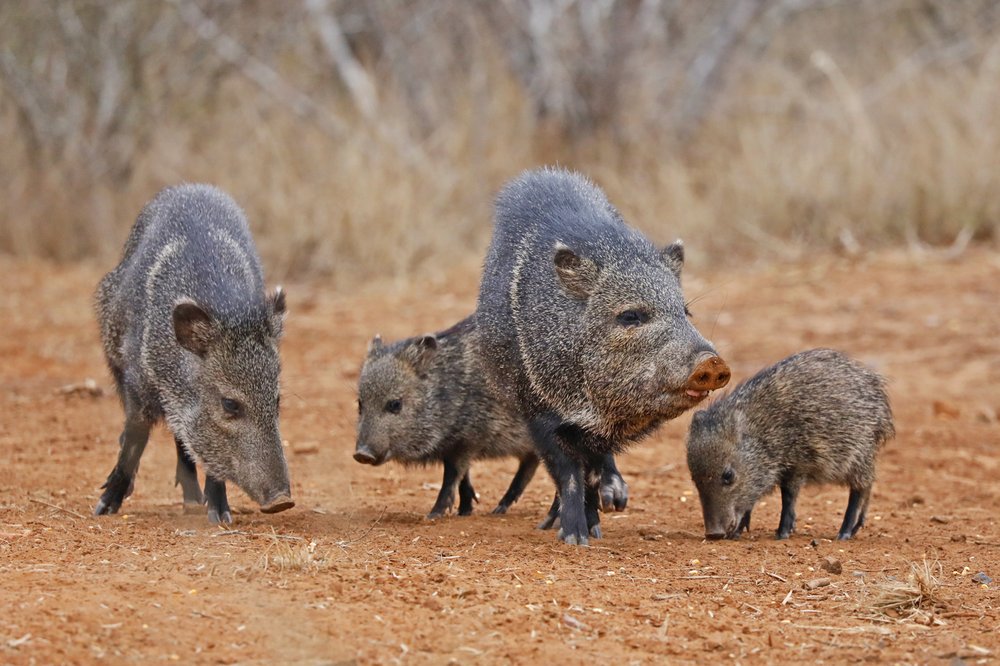
Javelinas often spend time in family groups.
Joseph Richards
Javelinas often spend time in family groups.
Joseph Richards
Research in South Texas
The increasing interest in javelinas is not just from hunters. “More people are already interested in javelina ... landowners are recognizing their potential and importance,” says Webb, who is a research assistant professor for the Texas A&M Natural Resources Institute and the project lead on the comprehensive javelina study in the South Texas Plains.
Despite having one of the largest distributions of any wild hoofed mammal (their range extends from the southwestern United States through Central America and as far south as Argentina), the javelina has not been the focus of studies into its ecology and status in Texas. Webb says the large-scale project’s main goal is to assess javelina population dynamics and habitat use. Researchers want to find out how many javelinas are roaming across Texas, and how environmental factors such as rain and drought might affect herd size. We know javelinas reside in the South Texas Brush Country and the Trans-Pecos region of West Texas, but are there specific habitats that are more suitable than others? The answers, along with new tools and survey techniques being developed, will help landowners and biologists make informed management decisions.
The research team at A&M is using aerial surveys (surveying approximately 250,000 acres with helicopters) and more than 200 remote cameras to estimate population sizes across six ranches. They will compare the population estimates with roadside counts as a metric for indexing javelina. By validating roadside counts with population estimates from helicopter and camera surveys, Webb hopes that roadside counts will provide a reliable index for state biologists or landowners surveying javelinas.
The project’s live-trapping technique — using “smart” corral traps with remote-operated gates — allows researchers to capture whole squadrons and fit javelinas with GPS radio collars. At the 1.5-year mark of this five-year study, the team has deployed radio collars on 71 javelinas, creating an unprecedented window into their secret lives. The GPS location data from the collars will be used to develop a habitat and distribution model for the species and help predict where javelina will make their homes across the South Texas Plains.
“In addition to the GPS collar data, we will combine javelina detections from helicopter surveys, remote cameras and citizen science observations to identify what habitat resources javelinas are selecting and which areas are high priority for management,” Webb explains. “We are collecting any piece of information we can because there hasn’t been a whole lot of research on javelinas in Texas. We are taking hair samples for stable isotopes and genetic analysis, blood samples for disease and health assessments, and body measurements.”
Webb plans to use the long-term javelina data to develop an online tool so biologists can better manage javelina populations and possibly help them adapt to changing environmental conditions such as drought.
Respecting a Texas Native
The research couldn’t come at a better time. Javelinas have long suffered from a reputation problem, shrouded in misconceptions and dramatized lore that portrays them as dangerous, inedible creatures moving in packs through the brush.
An adult javelina can reach a weight of 55 pounds, stand 18 to 20 inches tall at the shoulder and grow to a length of three feet. It may look like a pig, but it belongs to the peccary family. Javelinas are omnivorous, which means they will eat almost anything available. On most ranges, prickly pear cactus makes up more than half of their diet.
Javelinas tend to remain in family groups, and the resulting herds usually contain five to 30 animals. If you see one javelina, you’re likely to see several. If you don’t see them, you might smell them. Javelinas possess a prominent scent gland on their backs near the rump. This gland emits a strong, musky odor used to identify herd members, mark territories and communicate danger.
A javelina’s coat consists of coarse, grizzled fur in shades of black and gray, with a distinctive white collar of bristly hair encircling its neck — a feature that earned it the name collared peccary. A prominent ridge of dark bristles runs along the animal’s spine from skull to tail, forming a pronounced mane. When the animal is threatened or agitated, these spinal bristles rise upright, creating an intimidating display that makes the javelina appear both larger and more menacing than its actual size.
Their straight, spear-like upper and lower canines can also make them look fearsome. In one of their unique behaviors, javelinas clap their upper and lower canine teeth together to make a “popping” or “clacking” sound as a warning.
Despite their reputation, javelinas are not normally aggressive toward humans. If startled (javelinas have poor eyesight), they may “bluff charge” an intruder, but it’s mostly for show.
Many people shy away from eating javelina. That’s one of the biggest misconceptions — that javelina has a gamey and musky flavor stemming from its scent gland. The truth? If handled and cooked properly, javelina make excellent Southwestern cuisine, especially in slow-cooked carnitas and savory tamales.
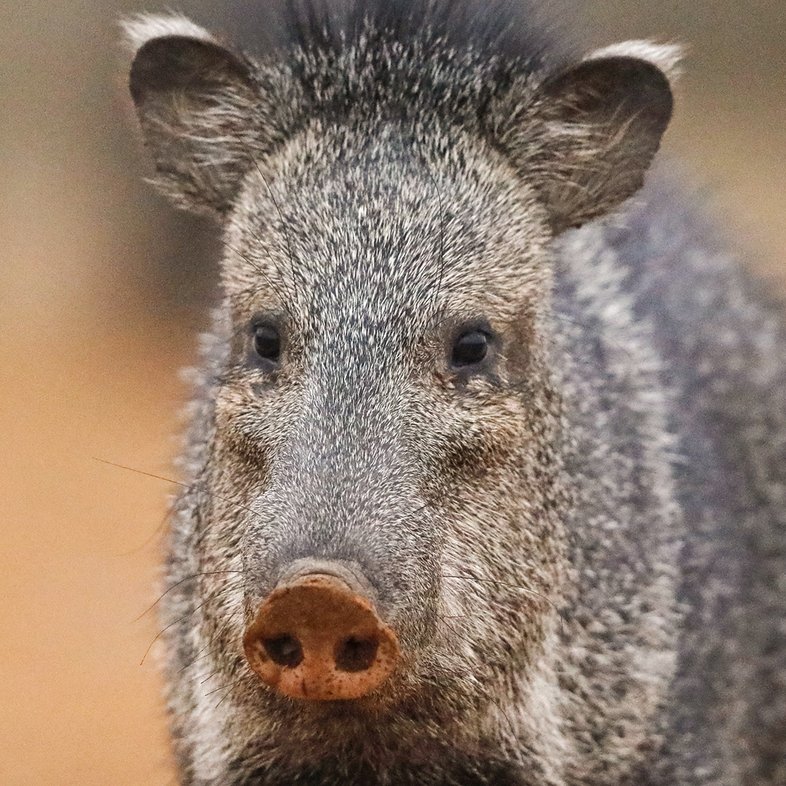
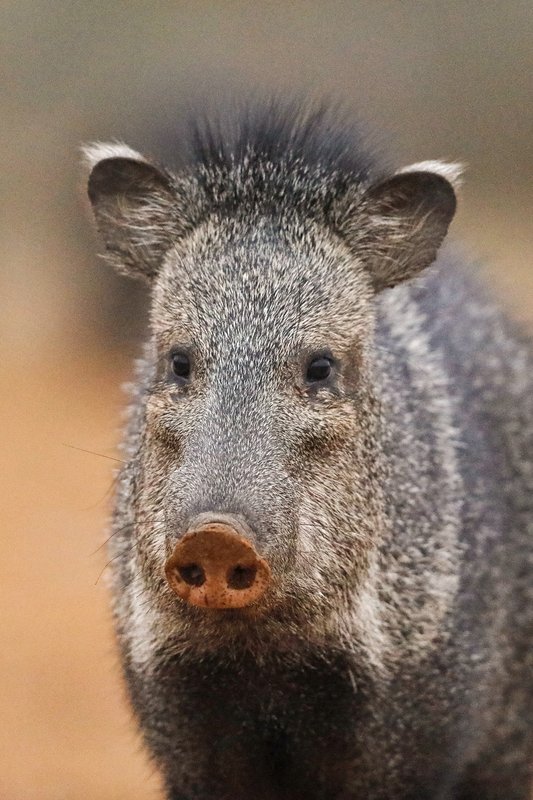
Their white "collar" gives javelinas their other common name, the collared peccary.
TPWD
Their white "collar" gives javelinas their other common name, the collared peccary.
TPWD
New Interest
Regardless of the debate over taste, one certainty is that javelinas are growing as a respected game animal in the state of Texas. In December 2024, the prestigious Boone & Crockett Club added a big game record category for javelina — officially recognizing what Texas hunters have known for years. “Javelinas are valuable as a native resource and are intrinsically important to the community,” says Gann. “There has been an interest in recent years to view and hunt javelina from folks out of state and amongst our own state hunters using alternative harvest methods such as archery.”
The Texas Wildlife Association has recognized and recorded javelina in the Texas Big Game Awards program for many years.
For landowners, javelina represent a potential new source of hunting income. “There may be an increasing number of landowners who are interested in managing for javelinas to provide hunting opportunities in the future,” Gann notes.
Perhaps most significantly, javelinas are proving to be ideal ambassadors for recruiting new hunters. Their manageable size, abundant populations and forgiving hunting techniques make them perfect for youth and first-time hunters.
With the success of his first hunt, A&M’s Tomassetti plans to be an ambassador for hunting and harvesting wild game. “I want to continue learning from experienced hunters and mentors, and in the future, I hope to be someone who can help others take their first steps into hunting, just like people did for me,” he says.
For javelinas, the South Texas sun is shining on them, with an elevated interest among hunters, wildlife professionals and the general public. New tools and techniques for informing management decisions should assist with the long-term goal of conserving and sustaining this native species.

